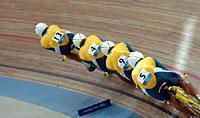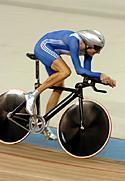
Recently on Cyclingnews.com |
The current time in Athens is 17:46 on January 5, 2026
Olympic Cycling News for August 23, 2004
Edited by Jeff Jones

|
Although there were fears before the Games that the Athens velodrome would be slow, the number of world records set in the opening three days of competition has erased all anxiety: Anna Meares going under 34 seconds in the women's 500m TT, Sarah Ulmer knocking a total of six seconds off the old record in the women's 3km IP, the Australian pursuit team lowering the 4km mark to 3:56 in the preliminaries and Brad Wiggins setting the best time (under modern UCI rules) in the men's 4km IP qualifying. It's rare that this many records are blown away at a single Olympic meet, especially at a sea level velodrome.
A combination of a high relative humidity, the warm temperatures in Athens, the track's dry, baked boards and of course the fact that some of the riders are in the form of their lives has led to the extremely quick times, and even some of the Olympic champions are eating their own words now.
"I wish I hadn't said in public about a week ago how slow the track was," said New Zealander Sarah Ulmer after she beat the world record twice in as many days to win the 3km pursuit title. She had barely stopped speaking when another huge roar came from the 3,300 sellout crowd at the Olympic Velodrome - the Australian men's pursuit team had just broken its 4km record.
"It is the combination of the track and the form of the riders," said Dutchwoman Leontien Zijlaard-Van Moorsel, who finished with bronze even though she was over three seconds faster than her previous world record.
The women's 3 kilometre record stood at 3 minutes, 30.604 seconds when the riders gathered under the spectacular roof of architect Santiago Calatrava covering the track. Three record races later it stands at 3:24.537, a massive improvement of over six seconds in two days. It had taken riders over a decade to bring the level down by the same margin to 3:30.604.
"If they would have told me I would have to ride 3:27, I would have declared them mad," Zijlaard-Van Moorsel said. The most successful cyclist in Olympic history did and it only yielded bronze.
Cyclists had called track too windy, too hot, too dusty. Since the roof sits over the track without covering the sides, there were fear swirling winds would throw riders off balance. "It is sad for the Games," said French multiple world champion Arnaud Tournant of the velodrome one day before setting an Olympic record on the course. It stood for only a few minutes before gold medalist Chris Hoy of Britain beat the mark over the 1 kilometre time trial.
Ahead of the games, track builder Ron Webb supervised a team of Greek workers to come in and shave 2mm off the Afzelia hardwood track to make it even smoother. It paid off, from the opening night. "I wasn't even looking at a world record, to tell you the truth, when I came here ... I never dreamed of it," Anna Meares of Australia said when she became the first woman to beat the 34 second mark in the 500 metres.
© AAP (Cyclingnews contributed to this report)
Missing decals - what's the story?

|
Observant Cyclingnews readers have noticed how some decals on the road bikes used in the Olympic Games have been taped over. Now that competition has moved to track, the offending decals on the highly-aerodynamic track bikes are being sanded back and painted over. This is due to the poorly-understood regulations of how much 'advertising' is allowed on the machines used in the Olympic events.
One bike supplier told Cyclingnews, "It's a bit weird, but it's the Olympics. Some decals are OK, others are not. The problem is, we don't know what is allowed." However, it's believed that the length and width of the main decal for some brands has been the issue, with the large brand name positioned along the frame's down-tube being the most offensive. If it's too big, then it gets covered completely and the top tube decal remains. If the down-tube decal is OK, then the top-tube is covered.
What is clearly not allowed are any team sponsors' names on the bikes, unless they are also the actual bike manufacturer. This would explain why the Alessio-Bianchi machines still carried the Bianchi decal, but not that of Alessio. However, on other bikes, the downtube decal is OK - presumably due to its smaller size and length - but then the decal on the head-tube is not allowed.
Consequently, team mechanics have been advised to either cover up or remove the offending decals. The thought of applying ugly duct tape to the sleek, aerodynamic machines used on the track has seen the mechanics using sandpaper to rub the decal back to the paint, and then the frames have been touched up to restore their appearance.
As one manufacturer said, "Without any clear guidelines on this, it's difficult. It can make them (the bikes) look a bit unprofessional as we go to so much trouble to prepare these bikes, and then we have to use tape or sandpaper to cover up the decals."
One thing is for certain, the UCI stipulates that any machine used in competition must be commercially available, even if the price tags may be a little stratospheric for the weekend warrior.
(All rights reserved/Copyright Knapp Communications Pty Limited 2004)
